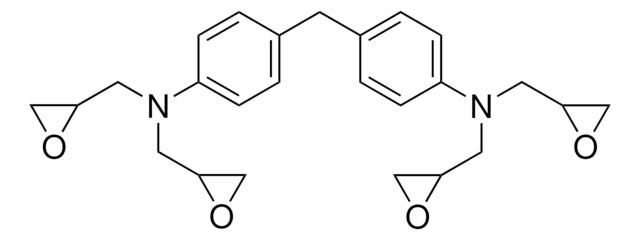430234
Bisphenol A diglycidyl ether, brominated
mol wt 350-450 g/epoxide by perchloric acid method
Synonyme(s) :
4,4′-(1-Methylethylidene)bis[2,6-dibromophenol] polymer with (chloromethyl)oxirane, 4,4′-(1-methylethylidene)bis(2,6-dibromophenol), Tetrabromobisphenol A-epichlorohydrin polymer
About This Item
Produits recommandés
Forme
solid
Niveau de qualité
Poids mol.
350-450 g/epoxide by perchloric acid method
Ampleur du marquage
48 wt. % Br
Viscosité
1,800 cSt(lit.)
Pf
55-65 °C (lit.)
Température de transition
softening point 55-65 °C (Durrans)
Solubilité
a variety of ketone, aromatic hydrocarbon and ether alcohol solvents: soluble
InChI
1S/C15H12Br4O2.C3H5ClO/c1-15(2,7-3-9(16)13(20)10(17)4-7)8-5-11(18)14(21)12(19)6-8;4-1-3-2-5-3/h3-6,20-21H,1-2H3;3H,1-2H2
Clé InChI
DEGGCMXJUHYWMD-UHFFFAOYSA-N
Description générale
Application
Propriétés physiques
Mention d'avertissement
Warning
Mentions de danger
Conseils de prudence
Classification des risques
Eye Irrit. 2 - Skin Sens. 1
Code de la classe de stockage
11 - Combustible Solids
Classe de danger pour l'eau (WGK)
WGK 3
Point d'éclair (°F)
235.4 °F - closed cup
Point d'éclair (°C)
113 °C - closed cup
Équipement de protection individuelle
dust mask type N95 (US), Eyeshields, Faceshields, Gloves
Faites votre choix parmi les versions les plus récentes :
Déjà en possession de ce produit ?
Retrouvez la documentation relative aux produits que vous avez récemment achetés dans la Bibliothèque de documents.
Les clients ont également consulté
Notre équipe de scientifiques dispose d'une expérience dans tous les secteurs de la recherche, notamment en sciences de la vie, science des matériaux, synthèse chimique, chromatographie, analyse et dans de nombreux autres domaines..
Contacter notre Service technique

